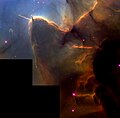Ficheru:Hs-1999-42-a-full jpg.jpg

Tamañu d'esta previsualización: 608 × 599 pixels. Otres resoluciones: 244 × 240 pixels | 487 × 480 pixels | 779 × 768 pixels | 1039 × 1024 pixels | 1516 × 1494 pixels.
Ficheru orixinal (1516 × 1494 píxels, tamañu de ficheru: 1,59 MB, triba MIME: image/jpeg)
Historial del ficheru
Calca nuna fecha/hora pa ver el ficheru como taba daquella.
| Data/Hora | Miniatura | Dimensiones | Usuariu | Comentariu | |
|---|---|---|---|---|---|
| actual | 17:30 1 mar 2010 |  | 1516 × 1494 (1,59 MB) | Tryphon | Reverted to version as of 22:21, 8 May 2009: 1,516×1,494 px is the original resolution; anything bigger is just scaled-up. |
| 17:24 1 mar 2010 |  | 3000 × 2957 (3,91 MB) | Justass | resolution | |
| 22:21 8 may 2009 |  | 1516 × 1494 (1,59 MB) | Fabian RRRR | {{Information |Description={{en|1=ABOUT THIS IMAGE: This NASA Hubble Space Telescope image of the Trifid Nebula reveals a stellar nursery being torn apart by radiation from a nearby, massive star. The picture also provides a peek at embryonic stars formi |
Usu del ficheru
La páxina siguiente usa esti ficheru:
Usu global del ficheru
Estes otres wikis usen esti ficheru:
- Usu en af.wikipedia.org
- Usu en ar.wikipedia.org
- Usu en bg.wikipedia.org
- Usu en ca.wikipedia.org
- Usu en de.wikipedia.org
- Usu en el.wikipedia.org
- Usu en en.wikipedia.org
- Usu en en.wikibooks.org
- Usu en es.wikipedia.org
- Usu en fa.wikipedia.org
- Usu en fr.wikipedia.org
- Usu en hr.wikipedia.org
- Usu en hu.wikipedia.org
- Usu en id.wikipedia.org
- Usu en it.wikipedia.org
- Usu en ja.wikipedia.org
- Usu en ka.wikipedia.org
- Usu en lb.wikipedia.org
- Usu en mk.wikipedia.org
- Usu en ml.wikipedia.org
- Usu en mzn.wikipedia.org
- Usu en pl.wikipedia.org
- Usu en pt.wikipedia.org
- Usu en ru.wikipedia.org
- Usu en sh.wikipedia.org
- Usu en sv.wikipedia.org
- Usu en uk.wikipedia.org
- Usu en vi.wikipedia.org
- Usu en zh.wikipedia.org
